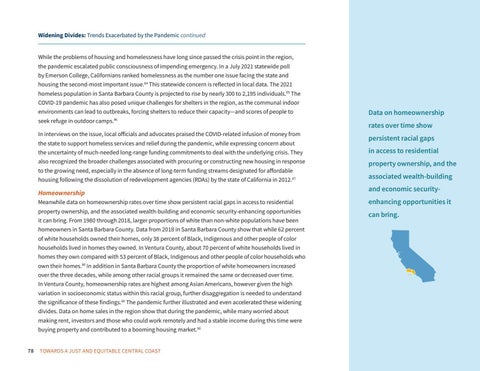Widening Divides: Trends Exacerbated by the Pandemic continued While the problems of housing and homelessness have long since passed the crisis point in the region, the pandemic escalated public consciousness of impending emergency. In a July 2021 statewide poll by Emerson College, Californians ranked homelessness as the number one issue facing the state and housing the second-most important issue.84 This statewide concern is reflected in local data. The 2021 homeless population in Santa Barbara County is projected to rise by nearly 300 to 2,195 individuals.85 The COVID-19 pandemic has also posed unique challenges for shelters in the region, as the communal indoor environments can lead to outbreaks, forcing shelters to reduce their capacity—and scores of people to seek refuge in outdoor camps.86 In interviews on the issue, local officials and advocates praised the COVID-related infusion of money from the state to support homeless services and relief during the pandemic, while expressing concern about the uncertainty of much-needed long-range funding commitments to deal with the underlying crisis. They also recognized the broader challenges associated with procuring or constructing new housing in response to the growing need, especially in the absence of long-term funding streams designated for affordable housing following the dissolution of redevelopment agencies (RDAs) by the state of California in 2012.87
Homeownership Meanwhile data on homeownership rates over time show persistent racial gaps in access to residential property ownership, and the associated wealth-building and economic security-enhancing opportunities it can bring. From 1980 through 2018, larger proportions of white than non-white populations have been homeowners in Santa Barbara County. Data from 2018 in Santa Barbara County show that while 62 percent of white households owned their homes, only 38 percent of Black, Indigenous and other people of color households lived in homes they owned. In Ventura County, about 70 percent of white households lived in homes they own compared with 53 percent of Black, Indigenous and other people of color households who own their homes.88 In addition in Santa Barbara County the proportion of white homeowners increased over the three decades, while among other racial groups it remained the same or decreased over time. In Ventura County, homeownership rates are highest among Asian Americans, however given the high variation in socioeconomic status within this racial group, further disaggregation is needed to understand the significance of these findings.89 The pandemic further illustrated and even accelerated these widening divides. Data on home sales in the region show that during the pandemic, while many worried about making rent, investors and those who could work remotely and had a stable income during this time were buying property and contributed to a booming housing market.90 78
TOWARDS A JUST AND EQUITABLE CENTRAL COAST
Data on homeownership rates over time show persistent racial gaps in access to residential property ownership, and the associated wealth-building and economic securityenhancing opportunities it can bring.
